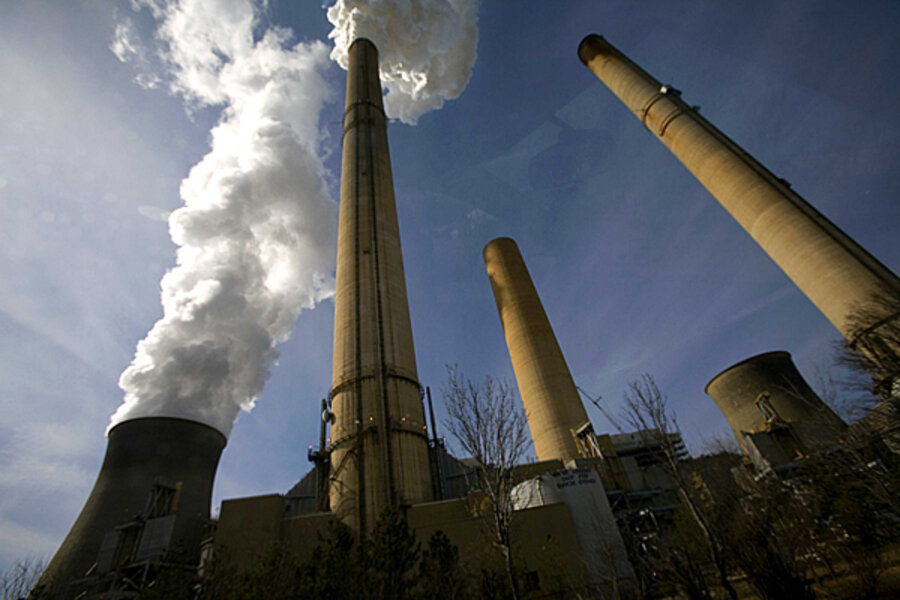Who can force utilities to cut greenhouse gases? Supreme Court to decide.
| Washington
Fed up with the slow pace of government efforts to address global warming, a group of conservationists and state attorneys general filed lawsuits in 2004 asking a federal judge to order five major US power companies to cap and then reduce their emissions of carbon dioxide.
Seven years later, the case arrives at the US Supreme Court, where the justices must decide whether concerned citizens and state officials have the legal power to force suspected polluters to cut their alleged level of pollution – though the federal government itself has not yet taken action on carbon emissions.
The 2004 lawsuits were a bold move taken at a time when the Bush administration’s Environmental Protection Agency (EPA) balked at claiming authority to regulate greenhouse gases. Some in the administration questioned the validity of research warning of the risk of global warming.
QUIZ: An "Are you smarter than Al Gore" energy quiz
Lawyers for the power companies moved to dismiss the lawsuits, arguing that global warming was an issue of public controversy that should be resolved by the political branches of government, not the judiciary.
A federal judge agreed and threw the lawsuits out. But an appeals court panel in New York reversed that decision, reinstating the suits.
The case, which comes before the Supreme Court on Tuesday, is important because it could open the way for an array of states and citizen groups to battle the threat of global warming and other environmental causes.
Corporations and business groups are concerned that the case could subject them to open-ended litigation over emissions of greenhouse gases outside any national framework established by Congress and enforced by the EPA.
One of the lawsuits was filed on behalf of six states and the City of New York. The states are New York, Connecticut, California, Iowa, Rhode Island, and Vermont. The other was filed by the Open Space Institute, the Open Space Conservancy, and the Audubon Society of New Hampshire.
Both suits accuse the five power companies of causing a public nuisance by operating fossil-fuel power plants in 20 states that emit 650 million tons of carbon dioxide a year. That amounts to roughly 10 percent of annual carbon-dioxide emissions in the US, according to the suits.
The power companies are American Electric Power Co., American Electric Power Service Corp., Southern Company, Excel Energy, and Cinergy Corp. The Tennessee Valley Authority is also a defendant in the suits.
The lawsuits say the defendants’ power plants are among the largest emitters of carbon dioxide in the world. The plaintiffs want a judge to order them to cap their greenhouse-gas emissions and then agree to a 10-year schedule to reduce them.
The potential difficulty of this approach is highlighted in a legal brief submitted by Acting Solicitor General Neal Katyal. The defendants’ power plants aren’t the only source of greenhouse gases contributing to global warming, he said.
“Virtually every person, organization, company, or government across the globe also emits greenhouse gases, and virtually everyone will also sustain climate-change-related injuries,” Mr. Katyal said.
The Obama administration is arguing on the side of the power companies that the lawsuits should be dismissed. Katyal said the EPA’s position on greenhouse-gas regulation has changed dramatically in recent years, with increased federal efforts to address the issue.
“EPA has taken substantial steps to regulate greenhouse-gas emissions under the [Clean Air Act], consistent with other high priority efforts by the executive branch to develop appropriate policies to combat climate change,” he wrote in his brief.
Without specific authorization from Congress, a federal judge lacks the power to adjudicate such generalized grievances and lacks the expertise to fashion an order requiring reduction of carbon-dioxide emissions, the solicitor general said.
Lawyers for the power plants agree. “The judiciary is ill-suited to that kind of inquiry unless and until Congress establishes statutory requirements reflecting … policy judgments,” wrote Peter Keisler in his brief.
“These decisions involve predictive judgments about every sector of the national and international economies and policy tradeoffs that turn on how the public values different potential economic, social, and environmental risks and benefits,” Mr. Keisler said. “They are precisely the kinds of judgments that are reserved for the political branches.”
In her brief on behalf of the states, New York Solicitor General Barbara Underwood said the suits against the power plants can be handled like any other public nuisance claim filed in the courts.
“Public nuisance suits are governed by well-established principles that the courts are fully capable of applying in the specific factual context of climate change,” Ms. Underwood wrote.
She said an individual judge would not have to resolve the worldwide problem of global warming. Rather, the relevant issue would be the feasibility of reducing the power plants’ contribution to the nuisance by reducing carbon-dioxide emissions.





